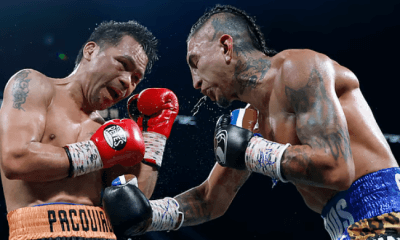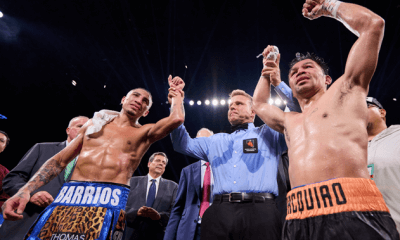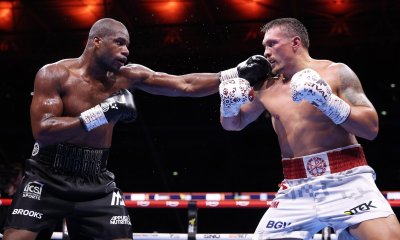Articles of 2004
Emile Griffith Goes the Distance
Former welterweight, junior middleweight and middleweight champion Emile Griffith punched his way into the Boxing Hall of Fame.
Griffith was born on February 3, 1938 in St. Thomas, Virgin Islands and was athletic from the start. “I was a baseball player,” he told me. “I was a catcher.”
The fact that Griffith played ball was of some minor interest, but nothing compared to the fights.
“When I was in the Virgin Islands, I would fight when I had to fight. When they pick on me, you know, I had enough of it,” Griffith said. “But I never wanted to be a fighter, to tell you the truth.”
Emile Griffith moved to the New York when he was a teenager and “stayed with my grandmother in Harlem.” He also began working in midtown Manhattan.
“I was working for Howard Albert in designer ladies hats,” the champ said. “He was my boss at the job. It was a little hat factory. I was working for him and one day I asked him if I could remove my shirt because I was hot, and he told me yes and started questioning me. He asked if I ever play sports. I told him yes to all that. And then he asked if I ever boxed. I told him ‘no, I never boxed,’ which I didn’t. And then he took it from there.”
I spoke with Howie Albert and asked if he remembered that moment with Emile.
“He was a delivery boy at my millinery factory. It was hot in the factory. We didn’t have any air-conditioning. So he took his shirt off and he had the most amazing build of any person I ever saw. He had a 44 shoulder with a 26 waistline,” Albert said. “I was a frustrated boxer. I brought my boxing gloves and boxing shoes to the factory and, funny, they fit him, so I brought him to meet a guy named Gil Clancy. Gil had a great amateur team that had won awards everywhere and he was training fighters at a gym on 28th Street, the Department of Parks.”
Griffith said of Howie Albert: “He took me to Gil Clancy’s gym at 28th Street and Ninth Avenue and every day after work he would take me there. And that was it.”
Gil Clancy was one of the game’s great trainers. He worked with Ali, Foreman, Frazier, Quarry and De La Hoya, among others, but Emile Griffith was his pride and joy.
I asked Griffith what it was like when he first entered Clancy’s gym.
“When I started boxing and training, oh man, it was rough,” he recalled. “They all wanted to fight me and everything else. But that thing was okay after that.”
I asked Albert what Clancy first thought of Emile Griffith.
“When I brought him to Gil, he says ‘you know, Howard, I never put a guy in the Gloves the first year. I like to keep them in the gym for a whole year.’ But then what happened was he never saw improvement in a fighter like Griffith. He was amazing,” Albert said. “He not only could box, but he could punch. I mean he was beating up the pros he had there! ”
Clancy became Griffith’s co-trainer and co-manager. With his help, Emile won the New York Golden Gloves. “Gil Clancy kept me very busy,” Griffith said, “and I enjoyed it too.”
Griffith turned pro on June 2, 1958, at the age of twenty, with a win over Joe Parham at St. Nick’s Arena. He had six fights in ‘58, nine in ‘59, and nine in 1960, including a big win over Luis Rodriguez in New York City.
On April 1, 1961, Griffith kayoed Benny (Kid) Paret in Miami with a left hook followed by a straight right to win the welterweight title. “I got lucky,” Griffith said. After one defense of the crown against Gaspar Ortega, Griffith fought Paret a second time in September and lost the split decision and title. Most people, including Griffith, think he was robbed.
Griffith met Paret for the third time six months later in Madison Square Garden. Paret dropped Griffith early, but Emile controlled the action. In the twelfth round he caught Paret in the corner and landed eighteen punches in a row. The referee that night, Ruby Goldstein, seemed glued to the spot. When he finally stepped in to stop the action, it was too little too late. Benny (Kid) Paret slumped unconscious to the canvas.
One of America’s best writers, Norman Mailer, who is also one of boxing’s best friends, was at the fight and wrote about the bout:
“Paret lay on the ground, quivering gently, a small froth on his mouth. The house doctor jumped into the ring. He knelt. He pried Paret’s eyelid open. He looked at the eyeball staring out. He let the lid snap shut. He reached into his satchel, took out a needle, jabbed Paret with a stimulant. Paret’s back rose in a high arch. He writhed in real agony. They were calling him back from death. One wanted to cry out, ‘Leave the man alone. Let him die.’ But they saved Paret long enough to take him to the hospital where he lingered for days. He was in a coma. He never came out of it. If he lived, he would have been a vegetable. His brain was smashed.”
The death was blamed, at least in part, on Paret’s manager, who let his fighter fight too soon after a beating he got from Gene Fullmer three months earlier. But the way Griffith won the fight, and the tragedy that followed, wore heavily on his mind. “I would have quit,” Griffith said, “but I didn’t know how to do anything but fight.”
So fight he did. But after the Paret incident, Griffith “changed my style of fighting and everything else. I didn’t have to punch somebody. I didn’t have to knock no one out to win a fight,” he said. “I could go the fifteen rounds or ten rounds or how many rounds it was. I could do it just by boxing.”
Griffith defended his welterweight title one more time that year, before winning the junior middleweight belt from Teddy Wright in Austria by decision. Emile lost his welterweight title to Luis Rodriguez via decision in Los Angeles on March 21, 1963, only to regain the crown three months later from Rodriguez at the Garden.
“He was a very good boxer,” Griffith said about Rodriguez. “I learned a lot on how to box a little bit more from him, just by boxing him.”
The champ had six fights in ‘63, six fights in ‘64 and seven fights in ‘65. On April 25, 1966, Emile Griffith moved up in weight and decisioned Dick Tiger to win the middleweight title. “I did a little more boxing than he could have done,” Griffith said. Two successful defenses against Joey Archer in New York led to the first of three fights with Nino Benvenuti. Griffith lost the first in 1967, regained the crown five months later, before losing it for good in March 1968 at the opening of the new Madison Square Garden.
Griffith fought for nine more years, including bouts with Jose Napoles, Carlos Monzon, Benny Briscoe and Vito Antuofermo. Emile Griffith had his last fight on July 30, 1977 against Alan Minter in Monte Carlo. He retired with a record of 85-24-2 (23 KOs).
“I have a lotta fights and a long record. You name them and I think I fought them,” Griffith said with a laugh. “I really enjoyed what I used to do. But I still like boxing. Boxing helped me along in my life and I still like it. As a matter of fact, I love it now. I go to the fights every chance I get. I watch the fights on TV. And I train some of the guys I’m with right now. Boxing was very good for me, so I figure if there’s anything I can do to help any one of the kids out there, I try to help them with it – if they want to do it.”
-

 Featured Articles2 weeks ago
Featured Articles2 weeks agoThe Hauser Report: Zayas-Garcia, Pacquiao, Usyk, and the NYSAC
-

 Featured Articles1 week ago
Featured Articles1 week agoOscar Duarte and Regis Prograis Prevail on an Action-Packed Fight Card in Chicago
-

 Featured Articles4 days ago
Featured Articles4 days agoThe Hauser Report: Cinematic and Literary Notes
-

 Featured Articles4 weeks ago
Featured Articles4 weeks agoResults and Recaps from NYC where Hamzah Sheeraz was Spectacular
-

 Featured Articles3 weeks ago
Featured Articles3 weeks agoManny Pacquiao and Mario Barrios Fight to a Draw; Fundora stops Tim Tszyu
-

 Featured Articles3 weeks ago
Featured Articles3 weeks agoArne’s Almanac: Pacquiao-Barrios Redux
-

 Featured Articles2 weeks ago
Featured Articles2 weeks agoRemembering Dwight Muhammad Qawi (1953-2025) and his Triumphant Return to Prison
-

 Featured Articles3 weeks ago
Featured Articles3 weeks agoOleksandr Usyk Continues to Amaze; KOs Daniel Dubois in 5 One-Sided Rounds














